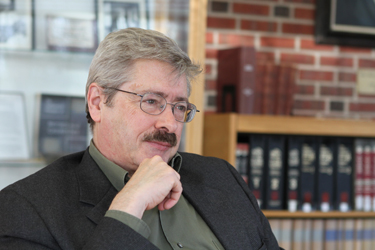
Steve Charles—A week ago last Friday I received one of those family phone calls you dread. My little brother tried to break the news with a joke—“I’ve got something in my brain and it rhymes with ‘rumor.’” Pause.
I felt a kick in the gut, then fear, then anger, which I expressed with an expletive, and then I asked a terrible question—“Are you scared?”
It wasn’t the response you hope to give a brother at a time of need. I’m not proud of it, but I understand it: Our mom died of lung cancer 30 years ago, and for her kids, a cancer diagnosis carries a single outcome and a series painful disappointments to get there.
A half-hour after the phone call, though, I was able to write something true and hopeful to my brother, thanks to a conversation I’d had with a former Wabash chemistry major, Dr. Tom Roberts ’70, in April, for a story for this fall’s Wabash Magazine.
Tom had been on campus to reflect upon the implications of the new generation of “smart drugs” being used to fight and manage cancer. He and his team helped develop one of those drugs—Gleevec—at the Dana Farber Cancer Institute at Harvard, and we’ve been following his progress since before those pills were featured on the cover of TIME Magazine in 2001 (The current issue has another story on the drugs’ success, “The End of Chemo.”).
At his noontime talk last spring Tom described how these drugs turn off molecular cancer triggers in tumors and prevent their growth, how a similar approach is being applied to more complex cancers than the relatively rare tumors Gleevec successfully treats, how tumors mutate and the ways drugs must adapt to stem their growth, and how this approach could work for treating many cancers.
So I was able to write honestly to my brother that I knew doctors who were beating cancer, that I’d written stories about these guys, the targeted approaches they’re using, and the lives they are saving. I said I wished these guys were around when mom was fighting this monster, but I’m grateful they’re here now that he’s facing it.
I could also tell him that the oncologists I’d interviewed, like Gary Croghan ’77 at the Mayo Clinic and Bob Witherspoon at the Fred Hutchinson Cancer Research Center, are compassionate men with a far better bedside manner and communication skills than the competent but emotionally distant oncologist that treated mom, a man my brother literally had to grab and hold in the hallway to get to talk with us.
I could draw from the interview in which Bob Witherspoon described advances in bone marrow transplants for leukemia: “I’ve had the great fortune to work in a field where we’ve gone from not being able to cure these people to being able to cure them.”
I remembered Gary Croghan (who treats the very type of lung cancer that killed my mom) describing meeting with his patients: “You meet with a patient for the first time for about an hour and a half. You’re giving them the worst news they’ve ever gotten in their lives. At the same time you’re trying to gain their trust. You have to read the family dynamics, see who has coping skills and who doesn’t. It’s one of the toughest things we do.
“I’ll explain the situation honestly, explain the options, and tell them that I’m glad to try to help. When they learn the odds, I’ll also tell them, ‘Look, I couldn’t do this job on a daily basis if I didn’t see people beat the odds.’”
It’s not the first time I’ve carried the words of Wabash men like a prayer.
This morning I was thinking back on my conversation with Tom Roberts. He said his own vocation has changed over the years. A Hoosier farm kid like many of our Wabash scientists, he described himself as a “lab rat” during his days at the College.
“But something has changed,” he said in his typically understated, self-effacing manner. “When I was 12, and even when I came to Wabash, I wanted to be a scientist; I wanted to find out new things. Working at a cancer institute, though, and seeing all the kids with no hair, the adults, too, and seeing all that they are facing, at this point my emphasis is more practical. I really would like to help cure cancer. Certainly, hanging out in a cancer institute, you wouldn’t be human if you didn’t respond to the problems of the patients.”
My brother’s “problems” may be just beginning, I know. He’s made it through surgery, is working through some post-operative pain and waiting for the pathology report, reading the messages and prayers from the now-784 folks who have visited his Caring Bridge site. Once glance at the and you’ll know he’s the best our family’s got; he’s the best fighter, too.
Those of us who love him feel mostly helpless. Not much we can do but pray and write and talk and spend too much time researching medical sites on the Internet.
At times like this, coming to work can seem the least relevant thing you can do. But this morning on my way to Wabash I found comfort, maybe even a tiny role in the process, working at a place that prepares the doctors and researchers who fight these battles alongside those facing cancer, a place which nurtures not only their technical skills and clarity of thinking, but also their empathy—men who bring that “always fights” attitude to the battle, a battle I believe my family will win this time.